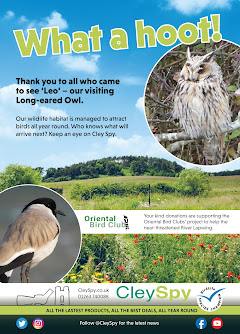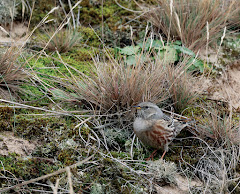Although they have only added one of his three regular pictures to the web. There is also a photograph of an Adder and a Dune Tiger Beetle in the newspaper today. Just emailed Sarah to ask if the other two pictures can also be added to the article.
Nature Notes - Lifestyle - Lynn News
I was told my paternal grandfather (who I never knew), used to practice taxidermy in order to augment his smallholding income. Thankfully, I never followed that lead.
However, my father had a small collection of wild birds’ eggs with which I became entranced. There was nothing for it but to follow that lead, but I was admonished never to take more than one egg from any nest.
Naturally I told my small friends about nests that I found. Sadly, the result was inevitable and the poor birds lost all their eggs. It was the beginning of the end of social intercourse and henceforth I kept my own counsel.
Further events added to my being a lone wolf. My father took me to my first football match. I found the noise, crowds and cold extremely unpleasant. I never went to another match! All school sport became abhorrent for me and this of course further established me as the “odd one out”.
A few years later I realised that being solo was essential when watching wildlife. I found that when visiting a nest concealed in vegetation no sign of my tracks could be left, otherwise predators would quickly plunder the nest. Every leaf and branch had to be left undisturbed. Fairly easy for one person to do, but very difficult if more.
My skills at nest finding were eventually put to scientific use when I joined the British Trust for Ornithology’s ringing scheme on the recommendation of the late Richard Richardson.
Between 1950 and 1958 I ringed nesting birds which included 191 nightingales, 88 young red-backed shrikes and 100 yellow wagtails. These numbers were never surpassed before or since. Subsequent reports of these ringed birds included a nightingale from South Portugal and a yellow wagtail found in France.
However, with burgeoning interest in natural history I found a few like-minded friends.
Two was usually the best number, occasionally three or four, but anything above that was a crowd and best avoided.
My first-hand experience of twitchers took place when I was warden at Holme Bird Observatory. With the arrival of a hoopoe one day twitchers came continuously to harass the bird from one of the dunes to the other. Such groups became the bane of reserve wardens. There was no respect for any opening hours or restricted areas. Their quarry was the rare bird and once seen, they were off to twitch any bird. Areas where these large groups stood became flattened. But thankfully the twitchers have responded well to restrictions and bad behaviour is now minimal.
I can appreciate the social intercourse that goes with this type of bird watching, but even now some reserves will rarely release news of any rare bird that might turn up, especially if nearby protected breeding birds are likely to be disturbed.
In March adders are likely to be seen emerging from their hibernation on local heaths and commons.
Go alone if you wish to see or photograph them at close range, but take care. Adders have a good sense of smell so approach their likely basking sunny spots by proceeding slowly into the prevailing wind. They are also acutely aware of any small vibrations underfoot, so tread softly!
Dragonflies are one of the sharpest-eyed (compound eyes) insects I have ever met and again best stalked slowly by one person. It will be late April or early May before the first ones are on the wing.
One summer’s day I went to one of the local sandy beaches in an attempt to find and photograph a dune tiger beetle. I was accompanied by my eldest sharp-eyed daughter. After much fruitless wandering around we suddenly saw one running across the shingly shore.
It is well known that this beetle is always reluctant to fly, but runs at great speed across the ground. it is one of the fastest runners in the insect world.
On this occasion four eyes were better than two and we slowly converged up to the resting beetle. Another problem ensued. It was rather a dull day and I was concerned that a flash shot would be difficult, so my hat was promptly taken by my assistant to cast a deeper shadow over the insect.
PETER CLARKE"
I remember that day very well and removing father's hat to assist with lighting!!!



































No comments:
Post a Comment